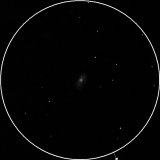
| MESSIER 49 |
|---|
RA: |
12h 29m 48s |
|
DEC: |
+08° 00' 00'' |
|
Type: |
Elliptical galaxy |
|
NGC: |
4472 |
|
Magnitude: |
8.40 |
|
Surface brightness : |
13.20 |
|
Apparent dimensions : |
10'x8' |
|
Distance: |
60,000,000 ly |
|
Elliptical galaxy M49 was the first member of the Virgo cluster of galaxies discovered, by Charles Messier who cataloged it on February 19, 1771. It is also the second galaxy discovered beyond the Local Group after Lacaille's discovery of M83. M49 is one of the brightest Virgo Cluster member galaxies with its mag 8.4, which corresponds to an absolute magnitude of approximately -22.8, regarding its distance of about 60 million light years. It is one of the giant elliptical galaxies in this great cluster (besides M60 and M87), and is of type E4 in Hubble's classification scheme. Its extension of 9 x 7.5 arc minutes corresponds to an ellipsoid with a projected major axis of nearly 160,000 light years (we don't know the real extension along the line of sight toward us, of course, as we don't know the spatial orientation of the real ellipsoid axes), so it is actually a big ellipsoid. Older estimates have suggested a mass which might be bigger than that of the nearby giant M87, but now it is assumed that M87 is much denser. With its integrated spectral class G7 and color index +0.76, it is yellower than most galaxies in the Virgo cluster. Longer exposures show a system of globular cluster, which however is much less crowded than that of M87 and more comparable to that of M60. A probable supernova, 1969Q, of mag 13.0 was reported in this galaxy in June, 1969. |
||
VEDRAN VRHOVAC© 2006.-2007. |
